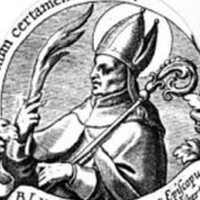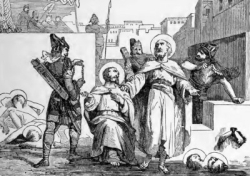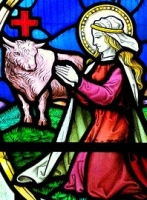St. Secundus
Died c. 119 AD
Venerated in Roman Catholic Church , Eastern Orthodox Church
Feast March 29
Attributes military attire; on horseback; sometimes depicted with Saint Maurice and the Theban Legion
Patronage Asti; Ventimiglia
Martyred Roman patrician (noble man) who was also serving in the Roman imperial army. Condemned for being a Christian, he was put to death at Asti under Emperor Hadrian.
Secundus of Asti (Italian: Secondo di Asti) (died c. 119) is venerated as a martyr and saint. His feast day is generally celebrated on March 29. Until the 15th century it was celebrated at Asti on March 30, but it is now celebrated there on the first Tuesday in May. He was a historical figure who was beheaded at Asti under Hadrian. He is said to have been a patrician of Asti and a subaltern officer in the imperial army. It is known that a church was dedicated to him in the area as early as the 9th century.[1]
Legend
Later legends made Secundus a member of the Theban Legion. A more elaborate legend states that he was a young man of noble lineage who visited the jails of Asti. Secundus was a friend of Sapricius (Saprizio), prefect of the city. They traveled together to the city of Tortona, where Secundus met the city's first bishop, Marcian, who was later martyred under Hadrian. Secundus' meeting with Marcian influenced his decision to become a Christian; his meeting with Faustinus and Jovita further influenced his conversion. His friend Sapricius attempted to make him abjure his newfound faith. Secundus refused, and was tortured and decapitated.
Veneration
The codex called the Codice della Catena depicts Saints Octavius, Adventor, Solutor, Maximus of Turin, John the Baptist, and Secundus of Asti.[2] Bernardo Strozzi painted his St Secundus and Angel around 1640
Saint Ludolf of Ratzeburg
Also known as
Ludolph
Profile
Praemonstratensian canon of the cathedral of Ratzeburg (modern Landkreis Herzogtum Lauenburg), Schleswig-Holstein, Germany. Priest. Noted preacher. Bishop of Ratzeburg in 1236. Imprisoned, severely beaten and exiled by Duke Albert Urso of Lauenburg, Saxony for defending the cathedra and preventing the Duke from confiscating its property. He was taken in by Duke John of Mecklenburg, but his injuries were so severe that he did not survive long. Martyr.
Died
• 29 March 1255 in Wismar, Holstein, Germany from injuries received in prison
• buried in the cathedral of Ratzeburg, Schleswig-Holstein, Germany
• some relics at the Saint Johann Premonstratensian abbey in Duisburg-Hamborn, Nordrhein-Westfalen, Germany
Canonized
14th century
Saint Jonas of Hubaham
Also known as
Jonah of Hubaham
Profile
Monk. Went with Saint Barachisius, his brother and fellow monk, to Hubaham, Persia, to minister to Chistians imprisoned for their faith during the reign of King Sapor II. They were arrested, beaten, tortured, and martyred for this service, and for refusing to worship the sun, moon, fire and water. Eyewitness descriptions of their trial and execution have survived to today.
Born
at Beth-Asa, Persia
Died
• martyred 24 December 327 by being beaten with clubs, a stake pushed into his abdomen, and left in a freezing pond; when he survived the night, his fingers and toes were cut off, and he was crushed to death in a wine press
• his corpse was cut in two, thrown in a dry cistern, and guarded to keep other Christians from recovering relics
Blessed Bertold of Mount Carmel (Bartold of Calabria)
கலபிரியா புனிதர் பெர்தோல்ட்
துறவி:
பிறப்பு: தெரியவில்லை
லிமோகெஸ், ஃபிரான்ஸ்
இறப்பு: கி.பி. 1195
கார்மேல் மலை
ஏற்கும் சமயம்:
ரோமன் கத்தோலிக்க திருச்சபை
நினைவுத் திருநாள்: மார்ச் 29
புனிதர் பெர்தோல்ட், ஒரு "நார்மன் ஃபிரெஞ்ச் சிலுவைப் போராளி" (Norman French Crusader) ஆவார். இவர் கி.பி. 1185ம் ஆண்டு, "கார்மேல் மலை'யில்" (Mount Carmel) ஒரு துறவியர் காலனியை (Hermit Colony) நிறுவினார். சற்றேறக்குறைய பதினைந்தாம் நூற்றாண்டில் "புனிதர் கார்மேல் மலையின் பெர்தோல்ட்" (Saint Berthold of Mount Carmel) எனும் பெயருடன் "கார்மேல் இலக்கியத்திற்கு" (Carmelite Literature) அறிமுகப்படுத்தப்பட்டார். இவர் "புனிதர் ப்ரோகார்ட்" (Saint Brocard) என்பவருக்கு முன்னதாக கார்மேல் சபையின் தலைவராக இருந்ததாக கூறப்படுகிறது.
பெர்தோல்ட், தென்மேற்கு ஃபிரான்ஸின் “மாலிஃபேய்” (Malifaye) எனும் இடத்தில், “லிமொஜெஸ்” (Limoges) எனும் பிரபுக்கள் குடும்பத்தில் பிறந்தவர்.
பெர்தோல்ட் உண்மையில் "கலாபிரியா" என்ற ஊரைச் சேர்ந்தவர் அல்லர். "கலாபிரியன்" (Calabrian) என்ற சொல், மேற்கத்திய நாடுகளில் பெயர்களின் முன்னால் சேர்க்கப்படும் ஒரு சமகால அலங்கார சொற்றொடராகும்.
புனித பூமியின் “அந்தியோக்கு” (Antioch) நகரில் “சாராசென்ஸ்” முற்றுகையின்போது (Siege by the Saracens) பெர்தோல்டு ஒரு சிலுவைப் போராளியாக அங்கே சென்றார்.
இக்கால கட்டத்தில், இறைவன் இயேசு இவருக்கு திருக்காட்சி தந்து, போர் வீரர்கள் தீய வழிகளில் செல்வதைக் கண்டித்தார். அக்காலத்தில், மேற்கேயிருந்து சிதறிய எண்ணற்ற துறவிகள் பாலஸ்தீனம் முழுதும் பரவி இருந்தனர்.
கி.பி. 1185ம் ஆண்டு, கார்மேல் மலை திரும்பிய பெர்தோல்ட், அங்கே சிறு தேவாலயம் ஒன்றினைக் கட்டி எழுப்பினார். சிதறுண்ட துரவியர்க்காக ஒரு சபையைத் தொடங்கினார். அதுவே பின்னாளில் கார்மேல் சபை என்று அழைக்கப்பட்டது.
இவர் தன்னுடன் பல சகோதரர்களை இணைத்துக் கொண்டு, பல துறவற இல்லங்களை கட்டினார். இவர் பலமுறை திருக்காட்சிகளை பெற்று தீர்க்கதரிசிகளைப் போல வாழ்ந்தார். இவர் மிக அர்த்தமுள்ள வகையில் தனது துறவற வாழ்வை வாழ்ந்தார். எப்போதும் இறைவனுடன் ஒன்றித்து செபித்தார். தனது சபைத் தலைவருக்கு பலவிதங்களிலும் உடனிருந்து உதவினார். இவர் இறந்தபிறகு இவரின் சபை எருசலேமிலும் பரவியது. தமது சபை பலவித இன்னல்களை சந்திக்கும்போதெல்லாம் இவர், இறைவனின் அருளால் மிகத் திறமையுடன் செயல்பட்டு தன் சபையை இக்கட்டுகளிலிருந்து மீட்டார்.
தாம் நிறுவிய சபையை நாற்பத்தைந்து வருடங்களுக்கும் மேலாக, தமது மரணம் வரை தலைமைப் பொறுப்பேற்று நடத்திய இவர், கி.பி. 1195ம் ஆண்டு மரணமடைந்தார்.
Also known as
bull; Bartold of Calabria
• Bartoldus, Bertoldo
• Bartholomew Avogadro
Profile
Soldier who fought in the Crusades and was in Antioch during its siege by Saracens. Following a vision of Christ, Bertold gave up the military life and became a hermit on Mount Carmel, trying to live like Elijah the Prophet. His reputation for holiness spread, other hermits were attacted to the area, including Saint Brocard, and the community gave inspiration for the founding of the Carmelites.
Born
Limoges, France
Died
c.1195
Saint Eustachio of Naples
Also known as
Eustatius, Eustasio
Additional Memorial
10 May (Archdiocese of Naples, Italy)
Profile
Mid-3rd-century bishop of Naples, Italy.
Died
• mid-3rd-century of natural causes
• relics stored in an urn and interred under the main altar of the church of Sainta Maria in Portanova in the 9th century
• relics re-discovered in 1616
• relics received canonical recognition in September 1884
Canonized
• Pre-Congregation
• Archbishop Decio Carafa formally extended the cultus to the entire diocese of Naples, Italy in 1616
• on 18 December 1884, Pope Leo XIII confirmed the cultus paid ab immemorial
Saint Armogastes of Africa
Profile
Servant of Theodoric, son of the Arian Vandal King Genseric. After Genseric renounced his Christianity and returned to his roots as a violent pagan, he demanded that Armogastes also renounce his faith. When the servant refused, he was tortured, enslaved in the mines of Byzacena, and then lived out the rest of his life as a prayerful cow-herd near Carthage. Genseric would not permit Armogastes to be killed so that he could deprive him of being a martyr.
Died
sometime after 460 of natural causes near Carthage, North Africa
Saint Saturus of Africa
Profile
Wealthy master of the household of the anti-Christian Arian and then pagan Vandal king Genseric. When Genseric cracked down on the faithful, he tortured Saturus and threatened him with complete poverty and loss of his family and freedom. Saturus refused to deny his faith. Genseric, not wanting to create another martyr for Christians to rally around, stripped him of everything, and Saturus lived out his days as a poor but prayerful miner and cowherd. Friend of and fellow-sufferer with Saint Armogastes of Africa.
Died
some time after 460 of natural causes near Carthage, North Africa
Saint Gwynllyw
Also known as
Gundleius, Gundleus, Winleus, Woollos, Woolo
Profile
Chieftain and layman. Proposed marriage to Saint Gladys, the daughter of Brychan of Brecknock. When Brychan refused, he kidnapped her, and the two started a violent life on the run. Father of Saint Cadoc of Llancarvan who eventually convinced Gwynllyw and Gladys to give up their violent ways, and follow a religious calling. Monk at Newport, Monmouthshire, Wales. Late in life he became a hermit in rural Wales. An Anglican cathedral is dedicated to him in Newport, Gwent, Wales.
Born
6th century Wales
Saint Barachisius
Also known as
Berikjesu
Profile
Monk. Went with Saint Jonas of Hubaham, his brother and fellow monk, to Hubaham, Persia, to minister to Chistians imprisoned for their faith during the reign of King Sapor II. They were arrested, beaten, tortured, and martyred for this service, and for refusing to worship the sun, moon, fire and water. Eyewitness descriptions of their trial and execution have survived to today.
Born
at Beth-Asa, Persia
Died
by having hot brimstone and pitch poured down his throat on 24 December 327
Saint Gladys
புனித கிளாடிஸ் (-500 AD)
மார்ச் 29
இவர் (#Gwladus) வேல்ஸ் நாட்டின் மன்னராக இருந்த ப்ரெக்னொக் என்பவரின் மகள்.
இவரைக் க்வின்லிவ் என்பவர் உயிருக்குயிராகக் காதலித்தார். இந்த க்வின்லிவ், கிளாடிஸின் தந்தையிடம் சென்று, "உங்களுடைய மகளை நான் மணந்துகொள்ளப் போகிறேன்" என்று சொன்னபோது, அவர் இதற்கு மறுப்பு தெரிவித்ததால், க்வின்லிவ் கிளாடிஸைத் தூக்கிக்கொண்டு போய் மணந்துகொண்டார்.
பின்னர் தன் மனைவி கிளாடிஸை வைத்துப் பிழைப்பதற்கு வழியில்லாமல் போனதால், அவர் வழிப்பறியில் ஈடுபட்டார்.
இந்நிலையில், தன் கணவர் செல்லும் பாதை சரியில்லை என்பதை உணர்ந்த கிளாடிஸ் அவரைக் கண்டித்து, நல்வழிக்குக் கொண்டு வந்தார்.
இதற்குப் பின்பு இவர்களின் இல்லறம் நல்லறமாய் இருந்தது. இறைவன் இவர்களுக்கு ஆறு குழந்தைகளைக் கொடுத்தார். இந்த ஆறு பேரையும் நல்ல முறையில் வளர்த்தெடுத்த கிளாடிஸ், தான் புனிதையானதோடு மட்டுமல்லாமல், தன் கணவரையும் ஆறு பிள்ளைகளையும் பின்னாளில் புனிதர்களாகச் செய்தார்.
Also known as
Gwladys, Gwaladys, Gladusa, Gwladus, Claudia
Profile
Daughter of Saint Brychan of Brecknock. When Saint Gwynllyw asked for her hand in marriage, Brychan refused. Gwynllyw kidnapped the girl, and the two started a violent life on the run. Mother of Saint Cadoc of Llancarvan who eventually convinced Gwynllyw and Gladys to give up their violent ways, and follow a religious calling. Nun at Newport, Monmouthshire, Wales. Late in life she became a hermitess in rural Wales.
Born
6th century Wales
Blessed Cecilia Attendoli of Cotignola
Also known as
Cecilia Codignola of Vigevano
Profile
Poor Clare nun in the monastery of Santa Chiara in Mortara, Italy. We know little about her, but she is described as a woman of great virtue, and as a miracle worker.
Born
latter 15th century, probably in Cotignola, Italy
Died
29 March 1531 of natural causes
Blessed Agnes of Chatillon
Also known as
• Agnes de Satillon
• Agnes du Catillon
• Agnese...
Additional Memorial
28 March (Cistercians)
Profile
Cistercian at the monastery of Beaupré, Belgium c.1200 where she served as sub-prioress and novice mistress. A visionary and ecstatic, especially after Communion, she was known for her love of, devotion to, and time spent in meditation on the Eucharist and the Passion of Christ.
Blessed John Hambley
Additional Memorials
• 29 October as one of the Martyrs of Douai
• 22 November as one of the Martyrs of England, Scotland, and Wales
Profile
Priest in the apostolic vicariate of England. Martyred in the persecutions of Queen Elizabeth I.
Born
c.1560 in Bodmin, Cornwall, England
Died
hanged c.29 March 1587 in Salisbury, Wiltshire, England
Beatified
22 November 1987 by Pope John Paul II
Saint William Tempier
Also known as
William of Poitiers
Profile
Canon regular at Saint-Hilaire-de-la-Celle. Bishop of Poitiers, France in 1184. Reformer who enforced discipline among his clergy. Persecuted for defending ecclesiastical freedom.
Died
• 29 March 1197 of natural causes
• miracles reported at his tomb, which became a pilgrimage site
Saint Mark of Arethusa
Profile
Bishop of Arethusa, Mount Lebanon. Attended the 351 synod at Sirmium where he produced a creed that got him falsely labelled an Arian. He was struck from the Roman Martyrology for years, but research by the Bollandists vindicated him and restored his name to the roles.
Died
martyred in 362 during the persecution of Julian the Apostate
Saint Simplicius of Monte Cassino
Profile
Benedictine monk. Spiritual student of Saint Benedict of Nursia. Third abbot of Monte Cassino.
Died
c.570 of natural causes
Saint Constantine of Monte Cassino
Profile
Monk. Spiritual student of Saint Benedict of Nursia, and succeeded him as abbot of Monte Cassino in Italy.
Died
c.560
Blessed Hugh of Vaucelles
Profile
Dean of the church in Cambrai, France. Cistercian monk at Vaucelles, France.
Died
1239 of natural causes
Saint Acacia of Antioch
Also known as
Acatia, Achatia, Achatio, Achartio
Profile
One of a group of 250 Christians martyred together in Antioch.
Saint Masculas of Africa
Profile
High-born noble in the court of Arian Vandal king Genseric. Martyr.
Died
beheaded in 464 in North Africa
Saint Archmimus of Africa
Profile
Marytred in the persecutions of the Vandal king Genseric.
Died
North Africa
Saint Lasar
Also known as
Lassar, Lassera, Lassara
Profile
Sixth century nun in Ireland. Niece of Saint Forchera.
Saint Firminus of Viviers
Profile
Sixth century bishop of Viviers, France.
Martyrs of Nicomedia
Profile
One of a group of seven Christians who were martyred together in the persecutions of Diocletian. We know nothing else about them but the names of two - Pastor and Victorinus.








No comments:
Post a Comment